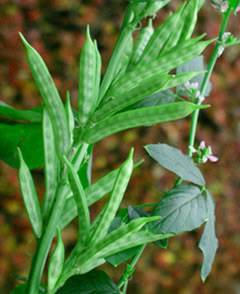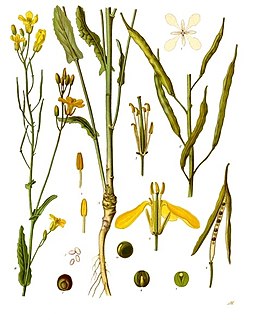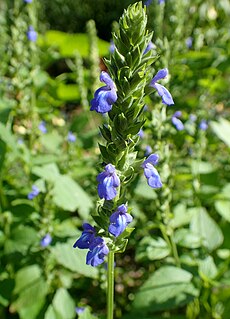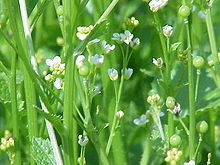
The guar or cluster bean, with the botanical name Cyamopsis tetragonoloba, is an annual legume and the source of guar gum. It is also known as gavar, gawar, or guvar bean.

Canola oil is a vegetable oil derived from a variety of rapeseed that is low in erucic acid, as opposed to colza oil. There are both edible and industrial forms produced from the seed of any of several cultivars of the plant family Brassicaceae.

Rapeseed is a bright-yellow flowering member of the family Brassicaceae, cultivated mainly for its oil-rich seed, which naturally contains appreciable amounts of erucic acid. Canola are a group of rapeseed cultivars which were bred to have very low levels of erucic acid and are especially prized for use for human and animal food. Rapeseed is the third-largest source of vegetable oil and second-largest source of protein meal in the world.
Erucic acid is a monounsaturated omega-9 fatty acid, denoted 22:1ω9. It has the chemical formula CH3(CH2)7CH=CH(CH2)11COOH. It is prevalent in wallflower seed and other plants in the family Brassicaceae, with a reported content of 20 to 54% in high erucic acid rapeseed oil and 42% in mustard oil. Erucic acid is also known as cis-13-docosenoic acid and the trans isomer is known as brassidic acid.

Salvia hispanica, commonly known as chia, is a species of flowering plant in the mint family, Lamiaceae, native to central and southern Mexico and Guatemala. It is considered a pseudocereal, cultivated for its edible, hydrophilic chia seed, grown and commonly used as food in several countries of western South America, western Mexico, and the southwestern United States.

Cyperus esculentus is a crop of the sedge family widespread across much of the world. It is found in most of the Eastern Hemisphere, including Southern Europe, Africa and Madagascar, as well as the Middle East and the Indian subcontinent. C. esculentus is cultivated for its edible tubers, called earth almonds or tiger nuts, as a snack food and for the preparation of horchata de chufa, a sweet, milk-like beverage.

Camelina sativa is a flowering plant in the family Brassicaceae and is usually known in English as camelina, gold-of-pleasure, or false flax, also occasionally wild flax, linseed dodder, German sesame, and Siberian oilseed. It is native to Europe and to Central Asian areas. This plant is cultivated as oilseed crop mainly in Europe and in North America.

Oenothera biennis, the common evening-primrose, is a species of flowering plant in the family Onagraceae, native to eastern and central North America, from Newfoundland west to Alberta, southeast to Florida, and southwest to Texas, and widely naturalized elsewhere in temperate and subtropical regions. Evening primrose oil (EPO) is produced from the plant.

Guizotia abyssinica is an erect, stout, branched annual herb, grown for its edible oil and seed. Its cultivation originated in the Eritrean and Ethiopian highlands, and has spread to other parts of Ethiopia. Common names include noog/nug ; niger, nyger, nyjer, or niger seed ; ramtil or ramtilla; inga seed; and blackseed.

Chia seeds are the edible seeds of Salvia hispanica, a flowering plant in the mint family (Lamiaceae) native to central and southern Mexico, or of the related Salvia columbariae of the southwestern United States and Mexico. Chia seeds are oval and gray with black and white spots, having a diameter around 2 millimetres (0.08 in). The seeds are hygroscopic, absorbing up to 12 times their weight in liquid when soaked and developing a mucilaginous coating that gives chia-based foods and beverages a distinctive gel texture.

Thlaspi arvense, known by the common name field pennycress, is a flowering plant in the cabbage family Brassicaceae.
Crambe oil is an inedible seed oil, extracted from the seeds of the Crambe abyssinica, a multibranched annual plant that is native to the Ethiopian Highlands also known as Abyssinia. The oil has been shown to consist of 55-60% erucic acid. The Australian Farm Diversification Information Service writes:
Lallemantia oil is a seed oil, extracted from the seeds of the Lallemantia iberica. It contains 68% linolenic acid, making it an unusually rich source, and of potential commercial interest. Lallemantia oil has been discovered at a number of archeological sites in northern Greece, dating from the Bronze Age. As the plant is not native to this region, the presence of this oil suggests that it was imported from further east.

Nervonic acid is a fatty acid. It is a monounsaturated analog of lignoceric acid (24:0). It is also known as selacholeic acid and cis-15-tetracosenoic acid.

Brassica carinata is a species of flowering plant in the Brassicaceae family. It is referred to by the common names Ethiopian rape, Ethiopian mustard. It is believed to be a hybrid between Brassica nigra and Brassica oleracea.

Sinapine is an alkaloidal amine found in some seeds, particularly oil seeds of plants in the family Brassicaceae. It is the choline ester of sinapic acid.

Ambadi seed oil is extracted from seeds of the ambadi plant. It is an annual or perennial plant in the family Malvaceae and related to the roselle. It is believed to be native to Africa or Tropical Asia.

Sten Gustaf Stymne is a Swedish biochemist and professor emeritus in plant breeding at the Swedish University of Agricultural Sciences. During the years, Stymne has been one of the leaders in plant lipid biochemistry and was awarded the 2008 Terry Galliard Award as a recognition for his contributions to the field. Stymne has for many years been a frequent debater in various news media, criticizing Sweden and the European Union for its negative attitude towards plant biotechnology.
Bacillus methanolicus is a gram positive, thermophilic, methylotrophic member of the genus Bacillus. The most well characterized strain of the species, Bacillus methanolicus MGA3, was isolated from freshwater marsh soils, and grows rapidly in cultures heated to up to 60 °C using only methanol as a carbon source. The genome of B. methanolicus MGA3 was fully sequenced in 2014, revealing a 3,337,035 bp linear chromosome and two natural plasmids, pBM19 and pBM69.















